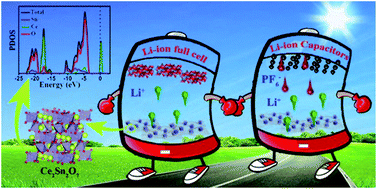Graphene encapsulated metallic state Ce2Sn2O7 as a novel anode material for superior lithium-ion batteries and capacitors†
Abstract
The development of bimetallic-based ternary materials (BTMs) has attracted much attention due to their multi-component flexibility and synergistic effect. Herein, BTM (Ce2Sn2O7) nanoparticles are encapsulated into graphene (Ce2Sn2O7/RGO), which served as a novel anode material for lithium-ion batteries and capacitors (LIBs/LICs). Benefiting from the synergistic effects from two metal elements and the conductive networks of graphene, the optimized Ce2Sn2O7/RGO delivers a reversible capacity of 814.6 mA h g−1 at 0.05 A g−1, good cycling performance with a reversible capacity of 369.5 mA h g−1 after 1500 cycles at 1 A g−1 and a superior rate capability of 432.4 mA h g−1 at 2 A g−1 in Li+ half cells. Meanwhile, the detailed phase transition and kinetics analysis as well as the theoretical calculation are performed to investigate the reaction mechanisms behind the good electrochemical performance. Furthermore, the Ce2Sn2O7/RGO also shows good lithium-ion full cell and capacitor performances coupled with commercial LiCoO2 and activated carbon, respectively, which further demonstrates the application prospect of Ce2Sn2O7/RGO.



 Please wait while we load your content...
Please wait while we load your content...